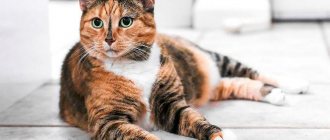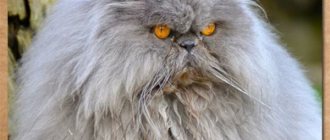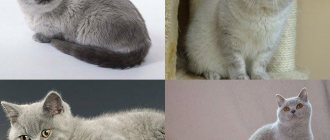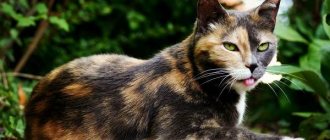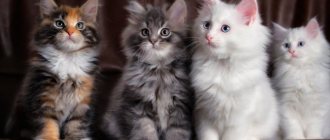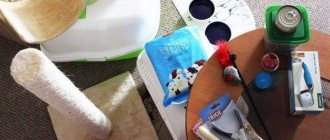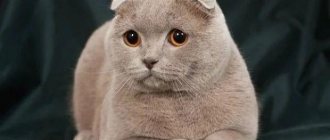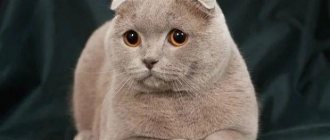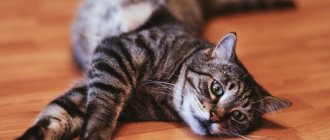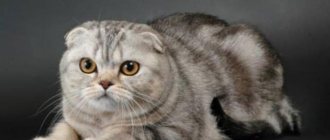What is tortoiseshell coloration in a cat?
The fur coat of a tortoiseshell cat combines a variety of shades from the black and red palette. It is covered with multiple multi-colored spots and stripes, differing in size and shape.
It is important to note that black points (colored areas) always have clear boundaries, while red points are always blurry. The eyes of such cats are usually orange or copper-gold, and the color of their nose and paw pads coincides with the predominant color of the color.
After such a description, many may have a misunderstanding about where the white color went. After all, very often it is he who decorates the “three-flowered” fur. The thing is that, from a scientific point of view, this term refers to the absence of color. White animals lack the pigment responsible for coloring their hairs.
White cat
Absolutely white albino cats are extremely rare. In fact, white color has nothing to do with albinism. These are completely different things. Albinism is recessive and is designated by the “c” gene, and there are two types of albinos: those with blue eyes and those whose eyes appear red.
Now about the genes that give white color. It depends on two genes, dominant - W and recessive - w. Moreover, the gene itself does not give any color, it simply suppresses other genes, which is why the cat remains white.
When crossing two cats with WW, the offspring will have a white coat, and cats with Ww will produce offspring with pigment. Such cats are more common.
White cats are often deaf due to the fact that the deafness gene is often “stuck” to the W gene or the S gene, which is responsible for the presence of white spots. Moreover, almost half of white animals are born deaf.
Genetic conditioning and inheritance
Speaking about color, it is necessary to clarify that this concept covers not only the color of the fur, but also the pattern on the fur coat. Melanin is responsible for the pigmentation of these zones, which is divided into 2 types:
- eumelanin, which gives black color due to the absorption of light rays;
- pheomelanin, which produces a red-yellow spectrum due to the reflection of light rays.
The appearance of an animal directly depends on the inherited genes. The listed pigments are contained in the X chromosomes and can give the following color options:
- black(oo);
- red (OO);
- tortoiseshell (Oo).
The remaining genes are responsible for color intensity, that is, its brightness, saturation and contrast. Based on this characteristic, colors are divided into white, agouti, tabby, solid, piebald, silver and acromelanic, that is, temperature-dependent. This diversity is explained by the need for camouflage among wild ancestors, who skillfully blended into their surroundings while hunting.
It is enough to look at solid shades to understand the possible variety. Red and black of varying intensity give the following options:
- blue or gray;
- chocolate;
- cream;
- blue-cream.
Please note that it is impossible to arrange chromosomes artificially, so the birth of a tortoiseshell kitten is a matter of chance. In a litter of turtle cats, completely ordinary babies with black or red coats are often born.
Features of genetics
The tortoiseshell color is characteristic only of females; for every 4 thousand females, only one cat is born. And this only happens because of a genetic mutation that affects the ability to reproduce. A tricolor animal encountered on the street will turn out to be female in 99% of cases.
The gender of pets is characterized by a set of X and Y chromosomes. A cat has XX combinations, a male has XY. The Y element does not contain any information about the shade of the coat, so only the X chromosome is responsible for the color. There are two genes that form a tricolor color: black - o and red-red - O.
Options for combining two elements XX:
- Ho and Ho - black shade of fur;
- XO and XO - red color;
- XO and Ho - tortoiseshell color.
Chromosomes are always arranged randomly, so breeders cannot predict the exact appearance of a kitten with tri-colored fur. Therefore, for now, the birth of tortoiseshell offspring is accidental, although such a pattern on the fur coat does not yet indicate the purebred of the animal. The mutation process causes the formation of various spots on the surface of the hair.
Types of tortoiseshell cats
The tortoiseshell color of a cat can cover the entire body or appear as a separate pattern. It is impossible to find identical variants, so they are often compared to human fingerprints. Despite this, felinologists highlight some characteristic features. Based on them, all turtle cats are divided into 3 varieties.
Torti, or scaly
This coloring resembles shiny fish scales. Small black and red spots are located in a chaotic order on the fur coat of a tortoiseshell cat. They do not have clear boundaries and symmetry, but the percentage of primary colors is always approximately the same.
Calico, or patchwork
The second variety is called calico. Cats with this tortoiseshell color look like they are wrapped in a patchwork quilt. Most of their body is painted white, and the rest is covered with multiple multi-colored spots that overlap each other.
Marble
Sometimes the tortoiseshell color of a cat is arranged in an unusual pattern, similar to marble. This combination is very rare, and is more often found in purebred cats.
Description of color
With this coat color, bright spots of two colors are visible throughout the animal’s body: most often red and black. Both of them are also necessarily present on the cat's paws. If you look closely at the photo of turtles, you can see a bright triangle on the animal’s face - this is a flame, another sign of a tortoiseshell color.
Usually not only the fur, but also the skin of the animal is multi-colored. Thanks to this, even a hairless sphinx can be a turtle. Also, along with an unusual fur coat, there may be eyes of two colors.
What breeds of cats have tortoiseshell coloring?
Most often, tortoiseshell colors are found in cats of certain breeds. These include:
- British.
Calm and balanced “Englishmen” are famous not only for their plush fur, but also for its unique colors. In addition to the classic options, you can find striped (tabby), rich beige (fawn) or cinnamon (cinnamon) representatives, like a stick of aromatic seasoning.
- Scottish folds.
Scottish Fold cats are usually black with occasional splashes of red or white. Unlike the British, they have more graceful proportions. Their main feature is the meerkat pose. They take this funny stance unconsciously when they are very carried away by the events taking place.
- Maine Coons.
"Maine Raccoons" comes from the state of the same name, where Stephen King himself lives. Most often, their coat is colored calico or tortie and has the tiger stripes characteristic of tabbies.
- Sphinxes.
Contrary to popular belief, sphinxes are not bald at all. Their fur is simply much shorter than normal. But this does not at all prevent it from being colored creamy-lilac, black-red, creamy-blue and red-chocolate.
- Persians.
Flat-faced and imperturbable, the mustaches have a standard red and black coat. In rare cases, their fur turns a less saturated creamy blue hue.
- Norwegian forest.
These fluffy beauties value their colorful fur very much. Experienced breeders recommend not to disturb Norwegians immediately after washing, as you can easily pay for violating cleanliness.
- Bobtails.
It was this breed that was used to create the famous Japanese Maneki-neko figurines. Their main feature is a short tail that resembles a fluffy pom-pom. Its length is 3-12 cm and depends on the number of caudal vertebrae.
- Turkish van.
Most of the body of these animals is colored milky white. Black and red points are present on her head and tail. They occupy no more than 15% of the rest of the body.
In addition to the listed representatives, “turtles” are also found among ordinary yard cats. After all, in fact, street mestizos are the result of mixing purebred animals. It's funny that it is their drawings that turn out to be the most unusual.
Breeds
Tricolor coats are common to many breeds. And even ordinary yard cats can often boast of an unusual fur coat. Among domestic breeds, turtles can most often be found among:
- Siberian cats;
- Japanese bobtails;
- sphinxes (Canadian and Don);
- Maine Coons;
- British;
- Scottish fold cats;
- Persian cats;
- rex (Ural, Selkirk, Devon, Cornish);
- American Shorthair;
- and among many others.
Thanks to genes, a tricolor color can appear in almost any cat, regardless of its breed. But the standards of some breeds are so strict that sometimes this color is not acceptable. In addition, various variations with tortoiseshell color are often limited.
For example, a British cat can have eyes of any color, but the undercoat must match the main color. The Kurilian Bobtail should not have diluted shades of black in its coat, and the Neva Masquerade cat must have blue irises.
Characteristics of tortoiseshell cats
The tortoiseshell coloration of cats cannot affect behavior. The character of an animal is always unique, but there are still some features characteristic of “turtles” of different breeds:
- Independence and ability to defend your opinion. Sometimes owners think that their colorful pets are too proud. They can be alone for quite a long time or become demonstrably offended, trying to get what they want.
- Friendliness. Despite the previous quality, with the right approach it is very easy to find a common language with these animals. They don’t know how to sulk for a long time, and closer to night they will definitely crawl into your bed. With proper upbringing, “turtles” grow up to be very docile and friendly, even towards strangers.
- High intelligence. Whiskered pets quickly remember the daily routine of their owners and skillfully take advantage of their weaknesses. They know what time breakfast, lunch and dinner start - and how to properly ask for the next refill.
- Playfulness. Of the listed breeds, this trait is not always shown in Persians and British. The thing is that these imposing couch potatoes love to play in the company of like-minded people. But only the same fluffy and mustachioed ones! Only a few are inclined to play with people.
Also, all these animals have in common the difficulty of litter box training. And the point here is not stupidity, but the stubbornness described above. If the “turtle” has chosen a place for its toilet that does not correspond to the one you chose, resign yourself and make a rearrangement. It will be much easier and faster than fighting and provoking another offense.
Signs and superstitions
Cats have always been surrounded by a veil of mystery and mysticism. From time immemorial they were considered guides to the other world and were often accused of aiding sorcerers and witches. Therefore, it is not at all surprising that such unusual, rarely seen animals with a tortoiseshell color are considered mystical. There are many signs and superstitions in different countries, but they all have one thing in common - a cat with a tortoiseshell color is a symbol of good luck:
- England . In this country, it is not customary to just give a tortoiseshell cat as a symbol of good luck and happiness. You must definitely give at least a small change for it, thus paying for further success, peace and love in the house. If a kitten with an unusual color comes into the house on its own, you also have to pay for happiness. At the intersection of 4 roads you need to put coins: it doesn’t matter what the amount is.
- Russia . In this country, any cat, regardless of breed and coat color, brought happiness and peace to the house. In Ancient Rus', cats protected the house from evil spirits, protected from evil spirits and enemies. It was especially good if the color of the animal’s fur matched the color of the owner’s hair. Then peace, comfort and love always reigned in the house, and good luck favored the household. In this regard, tricolor cats were considered universal. There are so many shades combined in the color of their coat that they will suit any hair color.
- Japan . In this country, cats are respected and loved by everyone, and animals with a tortoiseshell color are revered with greater honor. Figures with their image are placed near the entrance to each house, hoping that they will bring good luck. The Japanese prefer to have bobtails as pets, relying on the tortoiseshell color, because they protect the house and protect household members from evil spirits and bad thoughts of enemies.
- Arab countries . In the East, cats are held in special esteem, and they are more preferred as pets than dogs. Tortoiseshell cats protect against adversity, fire and theft.
- America . If in most countries tricolor cats are symbols of good luck, in America they are associated with money and material wealth. There is a belief in this country that if a tricolor cat comes to your house, it means that you can soon expect sudden enrichment. American bobtails are especially popular in the United States.
Also watch a video about tortoiseshell cats:
Are there tortoiseshell cats in the world?
The variegated colors come from the combination of two sex X chromosomes, and the ornate patterns and richness come from the genes contained on these chromosomes. But the fact is that males have only one X chromosome, and the second is represented by the Y chromosome, which does not carry information about color.
For this reason, the tortoiseshell cat is very rare, due to a genetic anomaly. They exist, but do not produce offspring, and their genotype (individual set of genes) looks like XXY.
This anomaly is called Klinefelter syndrome. It occurs when there is a deficiency of testosterone, the main male hormone. For this reason, in addition to infertility, turtle cats have a milder behavior characteristic of females. They are not allowed for breeding and are necessarily castrated - just in case.
“
Read more about calico cats
There is another variant of a genetic failure in which the ability to reproduce can be preserved. In this case, the genotype contains 4 chromosomes at once, that is, XYXY.
The most famous representative with this anomaly is a handsome, handsome Maine Coon named Mesomix. He looks like one of Batman's enemies - the villain Two-Face from the DC Comics universe. Such animals are called chimeras, since the inheritance of such an unusual genome occurs due to the fusion of two embryos inside the mother's womb.
Chimeras with heterochromia look the most interesting. But becoming the owner of such beauties is very difficult, since for every 3 thousand motley cats there is only 1 motley cat, and the chimera is even rarer.
Are there tricolor cats?
Only cats are genetically predisposed to the tortoiseshell color scheme. Tricolor males are born extremely rarely, and all of them suffer from disorders of the reproductive and endocrine systems. Due to a glitch in the genetic code, tortoiseshell cats live no more than 2-3 years.
Kinds
Felinologists distinguish two main varieties: patchwork and scaly.
Patchwork
Another name is calico. The English word "calico" means calico fabric. Calico combines clear spots of rich black, red and pure white colors and this really resembles a chintz blanket sewn from scraps.
Scaly
Another name is torti. A chaotic combination of colors is assumed here, for example, blue and cream or black and red. The spots are small, like scales, hence the name. Their boundaries are unclear, shades can flow into one another.
Why meet on the street
Accidentally meeting a multi-colored cat on the street is great luck. This situation promises a person a change for the better.
You can understand what benefits you can expect by paying attention to the details:
- a red tint predominates in the wool - it’s worth waiting for material wealth, it’s time to buy a lottery ticket;
- tricolor animal - to good news;
- “sprat” color, the cat is gray-white-black with a touch of red - success in your personal life, for single people - romantic adventures.
A meeting that occurs at dawn guarantees the fulfillment of a cherished desire; the day will be successful for all endeavors. If a three-haired animal comes towards you and rubs against your legs, expect acquisitions, pleasant expenses and receiving unexpected gifts. You can increase the chance of your prediction coming true by treating a stranger.
Wedding signs involving calico cats
Already in ancient times, the cat acted as the patroness of the hearth.
There are certain wedding beliefs associated with it.
:
- If a multi-colored cat wanders into your home, a wedding will take place soon.
- A pet sneezing while the bride is dressing indicates that life together will be harmonious and joyful. Even his presence promises success, happiness and mutual understanding with your future spouse.
- If a young representative of the strong half of humanity drank his last glass at a holiday, and there was a calico cat nearby (for example, under the table), then this year he will get married. On this occasion there is a certain ritual. It should be done right away. So, the father or older brother of the young man needs to pour milk for the pet and say the following words: “You have milk, and (the guy’s name) is a good wife.”
Interesting Facts
Several amazing facts and mystical legends are associated with tortoiseshell cats. Residents of the state of Maryland in the USA loved tricolor pets so much that in 2001 they recognized them as their official symbol. In the culture of eastern countries, such animals were considered talismans that bring good luck and wealth. They were specifically sought out and left to live at home in the hope that relations between family members would improve and regular income would increase.
The former Attorney General of the United States, on the other hand, was afraid of turtles. He considered them minions of the devil and even tried to create a decree for their extermination, but the population did not support such a decision. Japanese sailors take kittens with them on board their ships. According to legend, they protect ships from evil forces living in the seas and oceans. And if one of the crew members dreams of a turtle, then the ship will successfully bypass storm waves or avoid a collision with reefs.
In Kievan Rus, tricolor pets were called bogatki. This was due to the fact that according to legend, God endowed animals with magical abilities. Since dwellings, ships, barns and most furniture and household items were made of wood, fires often occurred. The turtle pet warned the owner in time about impending trouble and even reduced the risk of fire.
In Japan, a cult for such cats has long been created , and figurines of the animal were made . They were made from life, so every movement, tilt of the tail and head, and all the smallest spots on the fur were repeated. Sculptures decorated houses, protected them from the penetration of evil forces and poverty, and created a favorable atmosphere for plants and living cats. The British population brings home tortoiseshell animals to protect their homes from the evil eye and damage. Pets made the home more comfortable, and family members - calm and balanced.
You can love turtles not only for their unique appearance, but also for their kind character. Not all cat breeds can feel such deep love and devotion to their owner. If you give your pet enough attention, he will become a faithful assistant and a good friend for life.
Mr. Cat recommends: genetics of Tortie color and its varieties
The skins of cats of the "tortoiseshell" and "calico" colors are the result of the interaction of congenital and acquired genetic factors.
The primary coat color gene (B) is responsible for cinnamon, chocolate, brown and other similar shades. It may be masked by the codominant gene for orange (O), which is found on the X chromosome and has two alleles, orange (XO) and non-orange (Xo), producing red pheomelanin and black eumelanin pigments, respectively.
Typically, the designation "X" for a chromosome is taken from context, and alleles are designated only by uppercase "O" for orange or lowercase "o" for non-orange.
The Tortie and Calico cat colors are designated "Oo" to indicate that they are heterozygous for the gene.
The (B) and (O) genes can be further modified by the recessive dilute gene (dd), which softens the colors. For example, orange becomes cream, black becomes gray.
Different terms are used for certain colors, for example, gray is called blue or cyan, orange is also called ginger. Therefore, the tortoise shell color can be chocolate or bluish cream or similar shades based on the alleles for the B and D genes.
The cells of female cats, which like other female mammals have two X chromosomes (XX), undergo the phenomenon of X inactivation, in which one or the other of the X chromosomes is switched off randomly very early in development. The inactivated X is called the Barr body.
Cells in which the chromosome carrying the orange (O) allele is inactivated express an alternative non-orange (o) allele defined by the B gene.
Cells with the non-orange (o) allele inactivated express the orange (O) allele. Pigment genes are expressed in melanocytes, which migrate to the surface of the skin during later development.
In bicolored tortoiseshell cats, melanocytes appear relatively early, and the two cell types become intermixed, producing a characteristic mottled appearance consisting of a close mixture of orange and black cells, with occasional small diffuse patches of these same colors.
Bicolor tortoiseshell cat
In calico cats, a separate spotted gene develops in the coat color gene. It produces white, unpigmented patches by delaying the migration of melanocytes to the surface of the skin. There are a number of alleles of this gene that cause greater or lesser delays.
Calico Cat The amount of white is artificially divided into mitted, bicolor, harlequin and van, varying from an almost dark shade to almost completely snowy.
In extreme cases, the melanocytes do not reach the skin, and the cat is completely white (but not albino). In intermediate cases, melanocyte migration slows down because pigment cells develop late and have less time to mix with other tones.
Observation of calico cats shows that with a small amount of white in the color, the orange and black spots become more distinct, and with even more of it they are completely distinct. Each patch is a clone of cells derived from one original cell in an early embryo.
Tortoiseshell colors with a small number of snow spots are called “Cake plus white”; if there are a lot of light marks, then the term “calico” is used.
The tortoiseshell Calico color implies a calico cat. The word "Calicos" means "triple fur" in Japanese, and in Dutch the term "lapjeskat" (spotted cat) is used.
Also read the article about whether there are tricolor cats.
The factor that distinguishes "tortoiseshell" from "calico" coloration is the nature of eumelanin and pheomelanin, this is partly dependent on the amount of white due to the influence of the snow spot gene on the overall distribution of melanin.
A cat that has both the orange and non-orange gene, Oo, and a light to almost white marking will be a variegated mixture of red (cream) and black (blue), reminiscent of a tortoiseshell. A cat with Oo alleles with a lot of white will have huge, well-defined patches of red (cream) and black (blue), and this is called "calico."
With intermediate amounts of white, a cat may have a calico pattern, a tortoiseshell pattern, or something in between, depending on other epigenetic factors.
A true tricolor should consist of three colors: white, red (orange, yellow or cream) pheomelanin and black (brownish or gray (blue)) eumelanin.
The tricolor should not be confused with the natural gradations in the striped coat. The shades that are present in the pale tabby stripes are not considered a separate color.
The variations of the tricolor are as follows:
- The basic "turtle shell" pattern has several different colors depending on the eumelanin color (locus B) and dilution (locus D).
- Thorbies display tabby patterns on both colors. Calico cats are also called calibers or tabicos.
